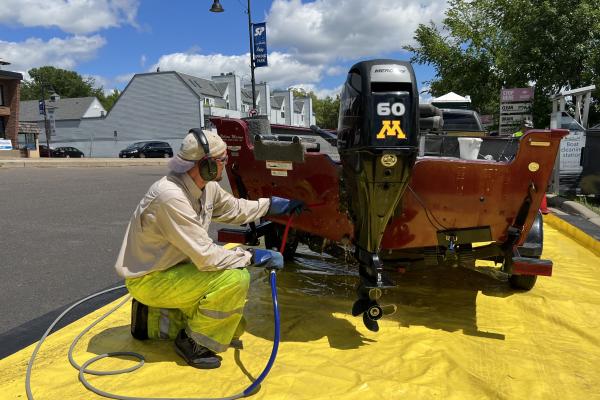Identifying “Day zero”: Strategies for eliminating a common and costly illness in pigs
December 1, 2023

Preparing to swab a piglet to test for pathogens.
A recent study led by College of Veterinary Medicine (CVM) researchers takes new steps to eliminating Mycoplasma hyopneumoniae (M. hyopneumoniae), a bacterium that causes respiratory illness in pigs. M. hyopneumoniae is one of the most significant bacterial swine pathogens worldwide, impacting animal welfare and causing significant economic losses for the swine industry. The findings from this study demonstrate a diagnostic strategy aimed at helping to eliminate the pathogen from individual herds—and eventually, to eradicate it altogether.
The study was led by Dr. Amanda Sponheim, a PhD student in the Department of Veterinary Population Medicine, and Dr. Maria Pieters, associate professor and director of the Swine Disease Eradication Center at CVM. Not only is M. hyopneumoniae costly for farmers, says Pieters, but the pneumonia it causes significantly impacts animal welfare: “These pigs are really suffering, and it essentially destroys the system that cleans their respiratory tract, opening the door to other infections.”
In the study, Pieters and her team honed in on the crucial step of confirming the exposure of female pigs newly introduced to a herd, known as replacement gilts, to the pathogen. Gilts are regularly introduced to herds to improve productivity, but that process can create an ongoing cycle of illness as replacement gilts and their piglets are exposed to disease circulating in a herd.
Because of that, one of the most important components in controlling or eliminating M. hyopneumoniae is herd closure, when no new animals are introduced to a herd while there are any positive cases. If a farmer is able to keep a herd closed until all of the pigs have passed through the infectious period, then new gilts and piglets can join a herd with no risk of illness, and the bacteria will have been effectively eliminated from the herd.
In order for a herd closure to be successful, it must be timed accurately to ensure that any positive animals have moved beyond the infectious period of about 8 months before reopening. This means that it’s crucial to identify “Day zero” for replacement gilts, or the first day of their infection after being introduced to a positive herd. Once Day zero is identified, the clock is effectively set for herd closure.
The study looked at different exposure techniques that are used on farms, as well as different sample collection approaches. Researchers determined that collecting specific samples from live pigs called deep tracheal secretions proved most effective for early detection of M. hyopneumoniae, thus allowing for the most accurate identification of Day zero.
In practical terms, the research offers valuable insights for farmers and veterinarians. It recommends tailored sample collection schemes based on the expected population exposure and challenges existing sample size guidelines. The findings propose a new approach to decide how many pigs to test and when, providing a more strategic and efficient way to manage—and eliminate—M. hyopneumoniae in pig herds.
According to Pieters, M. hyopneumoniae “is a difficult bacterium, and there aren’t a lot of resources out there. But in the last 15 years, the knowledge that we have generated at the University of Minnesota has been crucial for the design of strategies for disease eradication.”
These developments are a boon for animal welfare and for farmers: In some countries, use of these strategies has led to complete elimination of M. hyopneumoniae. And Pieters and her colleagues at the Swine Disease Eradication Center continue to design strategies that fit the North American production model—so that trend will continue globally, says Pieters, as commercial farms see the benefits.
Read the full study in Preventive Veterinary Medicine.


